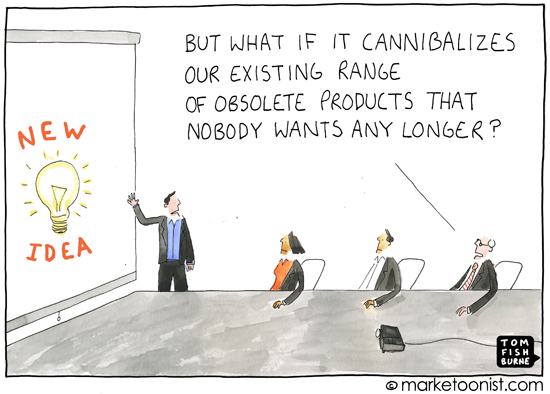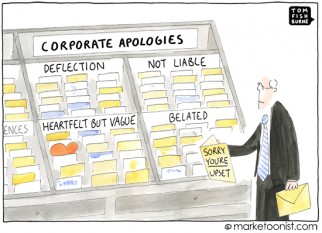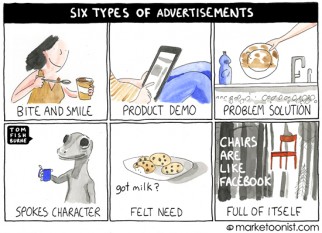“If you don’t cannibalize yourself, someone else will,” Steve Jobs famously said.
Cannibalization risk is a major factor in evaluating innovation. No product is 100% incremental so we have to decide whether new products will more than offset the sales loss of what’s already on the shelf. What’s often left out of the equation though is the risk of our current products becoming obsolete no matter what we do.
Kodak invented the first digital camera in 1975, over a decade before the first high-resolution digital camera was on the market. At the time, the Kodak film business was highly popular and profitable. This was two years after Paul Simon sang “Mamma don’t take my Kodachrome away”. Why would Kodak ever want to jeopardize that cash cow?
In the thirty plus years after inventing the first digital camera, Kodak resisted the shift from analog to digital at every turn. That strategy culminated in Kodak’s Chapter 11 filing earlier this year.
Apple has always preached creative destruction. Imagine the cannibalization analysis to launch the first iPhone when you have a phenomenally successful iPod already in the market. But that decision kept Apple ahead of the game.
Ultimately we can’t treat any of our products as sacred because our competitors surely won’t. If we want our products to succeed, sometimes we have to risk sacrificing them.
(Marketoonist Monday: I’m giving away one signed print of this week’s cartoon. Just share an insightful comment to this week’s post by 5:00 PST on Monday. I’ll pick one comment. Thanks!)



Tessa Stuart says
The other point to consider here is whether by moving into a related field, maybe even alongside your existing products on the shelf, you can bring in new users to your brand and match different need states. Innocent Drinks have a successful range of very healthy Veg Pots, with three portions of veg. I worked on a new product for them which might have sat alongside those Veg Pots on the shelf. This was where I tested its appeal. By reinvigorating an old tired unhealthy category in the unique way that Innocent branding does, and making it much more healthy, innocent would have brought new users into their brand for a new food. They might have had some cannabilisation, but they would gave grown their overall food market share, and brought younger users into the brand. This new product is not currently a priority for Innocent, who are concentrating on their core business. Which illustrates all the tension all businesses face between doing current business and developing new business, with the associated cost and distraction. And they innovated successfully in their core business with a rather good apple juice alongside the orange.
Jonas Holmström says
For Apple going from iPod to iPhone was a huge step. However the iPhone brings in more revenue per device than the iPod so cannibalization brought additional revenue. For many other companies like newspapers cannibalization might means replacing a huge (outdated) revenue stream/product line with a smaller, leaner product line. Newspapers of course resist losing revenue and cling on to their old business models only to watch it being eroded by companies that have nothing to lose.
Osize Om says
I had to reblog this one. The dilemma.
Carla Chynoweth says
This reminds me of a seminar I once attended in which a trader shared his insights into some of the key characteristics he recognised amongst the most successful people in his field. One was to be wrecklessly committed to only those areas which represented growth and profit, and to be able to detach yourself from non-profit bearing exercises. I think these equally appply to marketing – you have to avoid being sentimental even about legacy products and move with the times. A brand, like most examples of tradition, retains its authenticity and value when it is able to speak to today’s audiences.
Debbie Clewes says
I though I would cannibalize the Stephen Fry quote that is there for all to see outside the British Library:
“An original idea. That can’t be too hard. The library must be full of them.”
Perhaps better for this post as:
“An original product. That can’t be too hard. The marketplace is full of them.”
Mark Richards says
Stumbled across your site by accident and devoting third sandwich in a row to reading your old posts… But what do you cannibalize if you don’t have a physical product? As a writer, I have to go back and cannibalize old words. What I wrote on my website a year ago has become hopelessly out of date: my LinkedIn profile bears little resemblance to what I now do.
So for those of us without a physical product – or for those of us who’ve written about our physical product – maybe it’s not so much a process of cannibalization as a constant re-writing and a constant checking to make sure what you’ve written is still relevant.
Mind you, there are still one or two sentences I’m quite fond of…
Silke Zanker says
Great post. A common thread in some of the comments above and what I think is essential for innovation to happen is to challenge assumptions. Assumptions about the marketplace, the industry, how things are done but also about ones company and products.
When complacency settles in, innovation does not occur. And success is one of the factors that fosters complacency.
tomfishburne says
Hi all,
Great feedback everyone, thanks! This week’s cartoon goes to Tessa. The innocent veg pot case study is a wonderful snapshot at the real factors that go into these decisions. Thanks!
-Tom